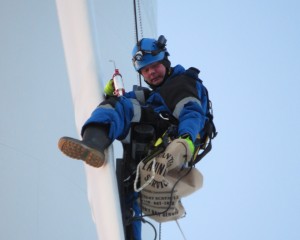Greger Nilsson left the research institute and took the power ascender to a new business. Now the former researcher is repairing blades far above the ground.
With his new company Blade Solutions Greger Nilsson is getting into the booming market of repairing blades. He knew a lot about composites from his work as a material expert at Swerea Sicomp before he started his company in October last year, but not much about wind energy, and even less about rope access.
”I had to take a crash course in up-tower repairing before I started my business,” he says.
Now he’s offering inspections and subsequent blade repairing with UV-curable resins, which cure within minutes and whose cure mechanism is not heat dependent.
For small repairs that require no fiber reinforcement, he uses RENUVO MPS (multipurpose system) resin, which is applied directly to the damaged area via a standard cartridge gun. The MPS resin, which is suitable for use on polyester or epoxy substrates, is a monocomponent system that requires no separate hardener.
For structural damages he uses UV-curing prepregs, (pre-impregnated glass fibres). To get top quality laminates, he also use vacuum assisted curing.
”When you develop a repair scheme, it’s critical that you understand the nature of composites, resins, fibers and orientation,” Greger Nilsson says.
For up-tower repair, there are several means of access: including crane-hoisted baskets, sky platforms anchored to the turbine, rope access during which repair technicians (generally in teams of two) lower themselves from the turbine via ropes to allow 360° access to the tower, nacelle and blades.
If possible, Greger Nilsson uses power ascenders. ”It’s cheaper for the customers and offers a great deal of flexibility for me.”
After half a year in the business he concludes there’s a lot of work to be done:
”I find wrinkles from faults made in the manufacturing process, puncture holes and cracks in the blade shells, which leaves the core exposed to water penetration, damages from lightning and leading-edge erosion.”
So far Greger Nilsson has done work for utility Skellefteå kraft, manufacturer Nordex, operator Kalix Vind. Competitors include Finnish company Bladefence, Danish Rytter Telecom and the turbine manufacturers themselves.
Facts:
During operation, as blades rotate, the blade tips can reach speeds of 180 mph/290 kmh. At that speed, rain- and wind-borne contaminants and sand can heavily erode leading and trailing edges
Composite wind turbine blades are designed to last for 20 years in the field. But those who service them say that without proper maintenance and repair, their actual service life will fall short, and during that shorter life, overall turbine efficiency will diminish. In fact, every defect on the surface of a wind blade disrupts its aerodynamic efficiency and, as a result, reduces the turbine’s power production.
In the harshest environments, leading-edge erosion is evident as soon as two years after installation


